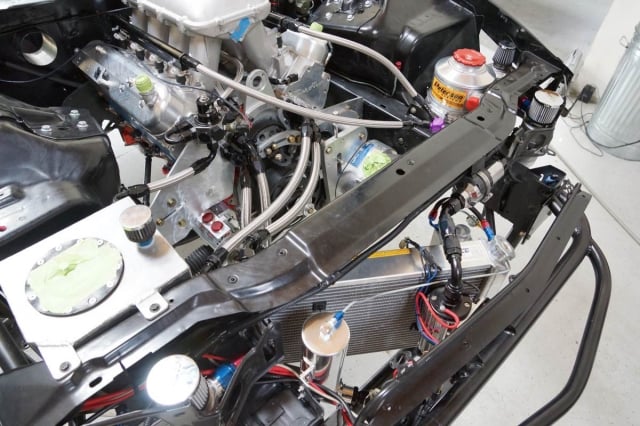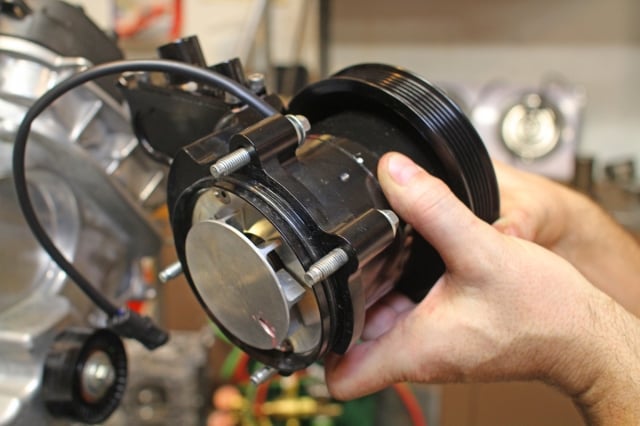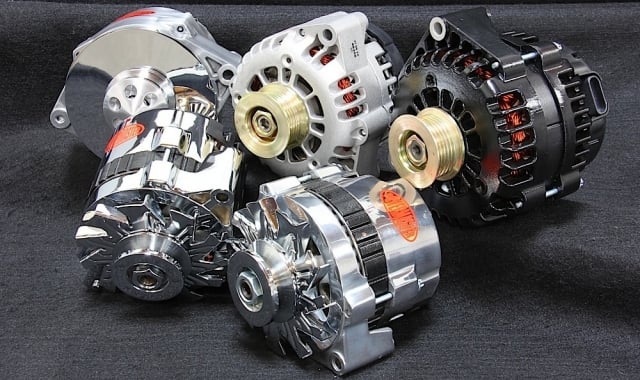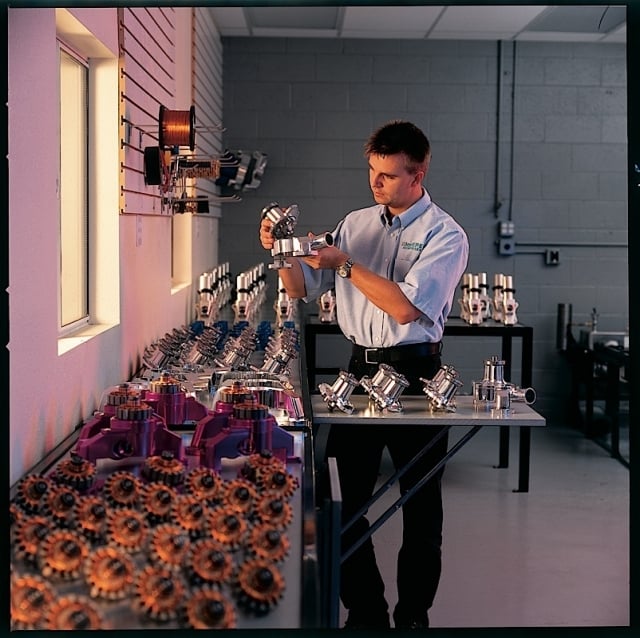 Electric water pumps are nothing new in the world of high-performance and even street-going engines. Through the years, though, they have evolved from something only seen on high-end, high output cars, and made their way into street/strip cars and other applications. They are often dismissed as a part used in dedicated race cars, when in reality, might benefit your street/strip car as well. But is an electric pump right for you? Read on and we will give you the answers!
Electric water pumps are nothing new in the world of high-performance and even street-going engines. Through the years, though, they have evolved from something only seen on high-end, high output cars, and made their way into street/strip cars and other applications. They are often dismissed as a part used in dedicated race cars, when in reality, might benefit your street/strip car as well. But is an electric pump right for you? Read on and we will give you the answers!
Two of the companies that have been building quality electric pumps for a number of years are Meziere Enterprises and Moroso, and we talked with both of them for this feature, to bring you a better idea of how these pumps work and when to consider using one.
How an Electric Water Pump Works
Electric water pumps function very much like your standard mechanical water pump. Operating as a centrifugal pump, a driven impeller rotates inside the housing to force water through the engine and back to the radiator where it is cooled, and the cycle begins again. Obviously the difference with an electric pump is that rather than being driven from a belt off the crankshaft, it is driven by an electric motor.
These two photos show the electric motor and impeller that make up the heart of a Meziere water pump.
Why Run an Electric Pump?
Determining if a vehicle can benefit from an electric water pump’s advantages is something that each enthusiast must consider. Though they are high performing parts with many benefits, an electric pump is not always the best suited part for every application.
Heat Control

This adapter kit from Moroso allows the use of their big-block Chevy water pump on LS engines, providing less weight over the stock pump, more coolant flow at idle and the option to run big-block Chevy accessories.
Electric water pumps are ideal for drag racing applications. In drag racing, engines are subjected to high levels of stress for short periods of time. These stresses build up heat that a traditional mechanical pump may not be able to keep up with after making a pass on the track. This is due to a mechanical pump’s dependance on engine RPM to generate more flow.
While a car is blasting down the track, the mechanical pump may be flowing at its maximum potential. However, on the return road, it is limited to only what it can do at idle. Also, once the engine is shut off, a mechanical water pump is no longer flowing water through the engine since there is no crankshaft RPM powering it. According to Don Meziere of Meziere Enterprises, “In drag racing, the engine builds a lot of heat in a short amount of time, and the electric pump allows you to cool the engine while it is shut off.”
That additional coolant flow leads to faster drops in engine temperatures between rounds. Additionally, because its flow rate is not RPM-driven and is often not varied by an external controller, the pump can cool the engine more efficiently during long idle periods, or during times when the engine is cycled through start up and shut down repeatedly, such as in the staging lanes waiting to make a pass.
Flowing anywhere from 20 to 36 gallons per minute (GPM) of coolant when installed, most electric water pumps can flow over three times what their mechanical counterparts are capable of at idle. “When we test a 55-gallon-per-minute-rated pump inside of a V8 system with a 17-by-22-inch” radiator we see about 22 gallons per minute, says Meziere.

This pump from Moroso features a clockable inlet to allow more flexibility in hose routing, and radiator placement or selection.
According to Meziere, most mechanical pumps tested in V8 applications flow approximately 8 GPM at idle, and around 70 GPM at 6,500 rpm. This is very good flow while at that RPM. However, it’s after a run on the race track or full throttle acceleration in a street car that an electric pump really shines.
With an electric water pump, the flow rate and pressure are nearly constant as the engine idles, makes a pass and pits or slows down. Being able to continue to remove heat from the engine by flowing coolant at a high rate, regardless of engine RPM helps to ensure the engine cools more evenly and quickly between rounds at the track or full throttle blasts in whatever activity the vehicle is involved in.
Power Gains
We can usually show gains from seven to 14 horsepower at 6,500 rpm. -Don Meziere, Meziere Enterprises
Some OEM-style mechanical water pumps may also not hold up to the high-RPM use often associated with high performance and drag racing engines. Many mechanical pumps are rated for 6,000 or 6,500 rpm. Above their intended operating range they may lose efficiency, and bearings and impellers also may not be designed to withstand the repeated stresses of such high RPM, leading to premature failures.
Packaging
Easier Belt Routing
Both Meziere and Moroso have developed solutions to the belt-routing issues on many of their pumps for late model applications. Several of these pumps such as the one for GM LS engines pictured above incorporate an idler pulley onto the front of the pump body. This takes the place of the original mechanical water pump pulley and allows for belt routing to be maintained without the need for a full re-engineering of the accessory drive system, or the use of additional idler pulleys.
Electric water pumps can, in some cases, present issues with packaging. When mounted in place of the original pump, belt drive systems must often be modified, especially in engines where the water pump may have driven other accessories, such as the alternator. “Switching to an electric pump can require a significant re-work to the belt routing or accessory drive system,” says Meziere.
In many cases, a set of idler pulleys can provide alternate routing for the drive belt, compensating for the absent water pump. Meziere recently developed a line of street pumps that incorporate an idler pulley into the body of the pump, allowing the original belt to maintain stock style routing.
Schroeder also points out an interesting feature of the Moroso LS engine electric water pumps. Moroso has designed adapters that allow the LS engine to utilize its big-block Chevy electric water pump. “The end result is that it eliminates the bulky LS water pump with a more compact, cost effective pump,” says Schroeder. Moroso’s BBC electric water pump weighs just 8-1/2 pounds.
“Electric water pumps weigh less than mechanical water pumps, so they are used when someone is trying to get every last pound that they can out of a car,” Schroeder points out.
Going with this particular Moroso water pump combination for an LS engine also allows the customer to switch their LS engine over to run big-block Chevy accessories, which on older vehicles may be more readily available and easier to fit to a classic car or truck. At the very least, it opens the door to a wider variety of accessories.

Our Project BlownZ uses a remote-mounted electric water pump for several reasons. The first is the use of a mid-plate to mount the engine. We’re also utilizing a belt-driven camshaft. Finally, for clearance with all the plumbing for our big ProCharger, dry sump oil system, intercooler and fuel system, a remote pump provides easier packaging.
Some engines also have packaging issues in terms of other components that are installed. For example, camshaft belt drives, large turbos or superchargers may require the removal of the original water pump. In these instances, a remote-mounted pump can be utilized to save space at the front of the engine. This allows for more ideal placement of large forced induction system components, or the use of a belt drive for the camshaft.
Parts Longevity
In all high-performance engines, component life and longevity become a concern. High-performance and racing environments place an accelerated strain on all components, in many cases demanding peak performance for most of the life of a part.
Moroso has customers using electric water pumps in street/strip applications that are over 20 years old with 60,000 miles on them. -Thor Schroeder, Moroso
Schroeder expressed similar confidence in Moroso’s pumps, “Moroso has customers using electric water pumps in street/strip applications that are over 20 years old with 60,000 miles on them.”

Meziere warranties their pumps for two years with no limit on the mileage to get the point across that they’re not just for drag race-only use. Should the motor experience a failure, it and the impeller can easily be replaced. This pump for a Ford Coyote swap is another example of a Meziere pump that offers an idler pulley in place of the stock water pump pulley to retain the factory belt drive system.
Matching the Cooling System
According to Meziere and Schroeder, cooling system components may need to be upgraded to accommodate an electric water pump. Typically, the radiator and fan assembly are the two most important components that will need to receive upgrades.
If the pump is allowed to run, cooling can be more effective and efficient while the engine is not running in the pits, versus simply opening the hood and allowing the engine to air-cool. Upgrading the radiator may be necessary in some applications. Larger radiator cores will allow for more heat dissipation as the coolant moves rapidly across the radiator. This is mainly due to the constant flow rate of an electric pump even at idle. As heat builds in an idle situation, coolant needs more time to dissipate the heat, and a larger radiator core allows for more surface area to cool the hot coolant.
Left: A relay kit like the one pictured here from Meziere may be needed when installing an electric water pump. Right: An electric fan and radiator upgrade may also be needed. The cooling system should be looked at as a complete system designed to work together and not necessarily as individual components.
An upgraded fan is also a wise choice in most cases. An electric fan system that can also be triggered to run while the car is parked, in conjunction with the water pump, can help further aid cooling system performance. In instances where a mechanical fan was still being operated by a mechanical pump, an electric fan conversion is required.
Additionally the use of a timer or thermostat-style switched system to control the fans and water pump may be a prudent choice. There are multiple styles of switching systems available for continuing to cool the car after shut down. Some simply allow the fans and pump to continue to work after the car is shut down, requiring them to be manually shut off later. Others work on a timer, or via a thermostat, shutting down once the coolant has reached a predetermined temperature.
There are also alternating switches that will cycle the water pump and then the fans. The strategy is to cycle hot coolant into the radiator, cool it with fresh air from the fans, then exchange it again for more hot coolant. Allowing the coolant to spend more time in the radiator, in theory, helps the radiator dissipate the heat from it more easily.
Electrical Upgrades
A vehicle’s electrical system must, of course, be up to the task of providing the necessary power for an electric water pump and electric fans. The pumps from Meziere and Moroso all draw from eight to 12 amps under continuous use, while possibly spiking a few amps higher at initial start up, which is the case with many electric motors. “Our heavy duty pumps will take no more than 12 amps as a steady draw,” says Meziere. Schroeder also states, “A Moroso electric water pump will draw 8 to 10 amps under load, so they can be used in a drag racing car that doesn’t have an alternator.”
This low current draw means that most racing applications will be able to run an electric water pump without the need for further upgrades. In a street or racing application, the total amperage available must be adequate to power the addition of an electric water pump.

While Meziere and Moroso electric pumps don’t draw high amperage for operation, checking your electrical system to make sure it’s up to the load is a wise idea, especially if you intend to add electric fans. An alternator upgrade may be in order for many street cars, especially older muscle cars.
While electric water pumps have relatively low draw, and on their own may not require an electrical upgrade, electric fans might change that picture if used as an additional cooling system upgrade in conjunction with an electric water pump. Many electric fans can draw from 15 to over 30 amps each. For racers it may not be as much of a concern, as the fans typically only run during cool down periods. However, for street going vehicles, the alternator output must be considered to ensure adequate charging system performance.
Making the switch to an electric water pump is something that must be carefully considered by any enthusiast, whether they are a hardcore racer, occasional track day participant, or their car is strictly street going. Careful consideration of vehicle use and analysis of the entire cooling system must be performed prior to an upgrade. Like any other system on the car, all the cooling system components should be matched to one another during an upgrade. Consulting with Meziere, Moroso or one of their authorized dealers before purchasing a pump is a wise idea, as they can provide proper direction and inform any consumer what component is right for their car. In the end, it’s all about keeping the engine cool and getting that win light on race day.
























